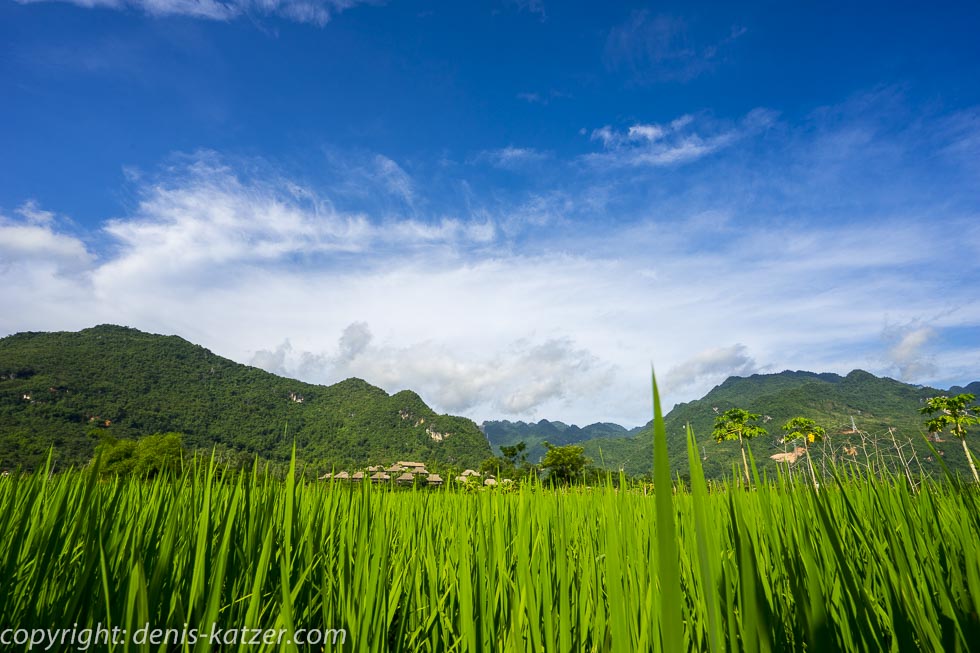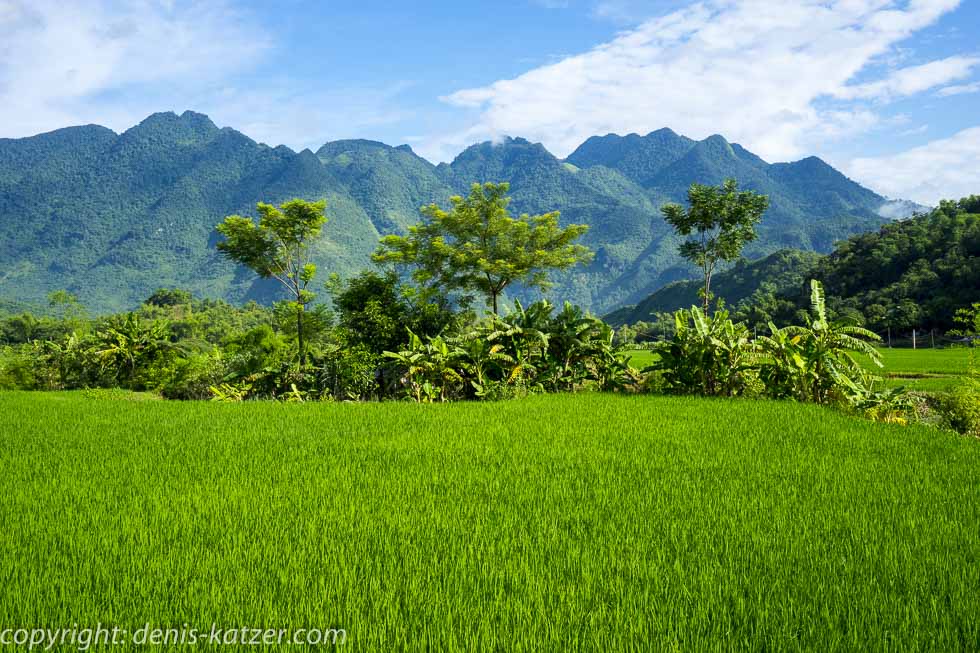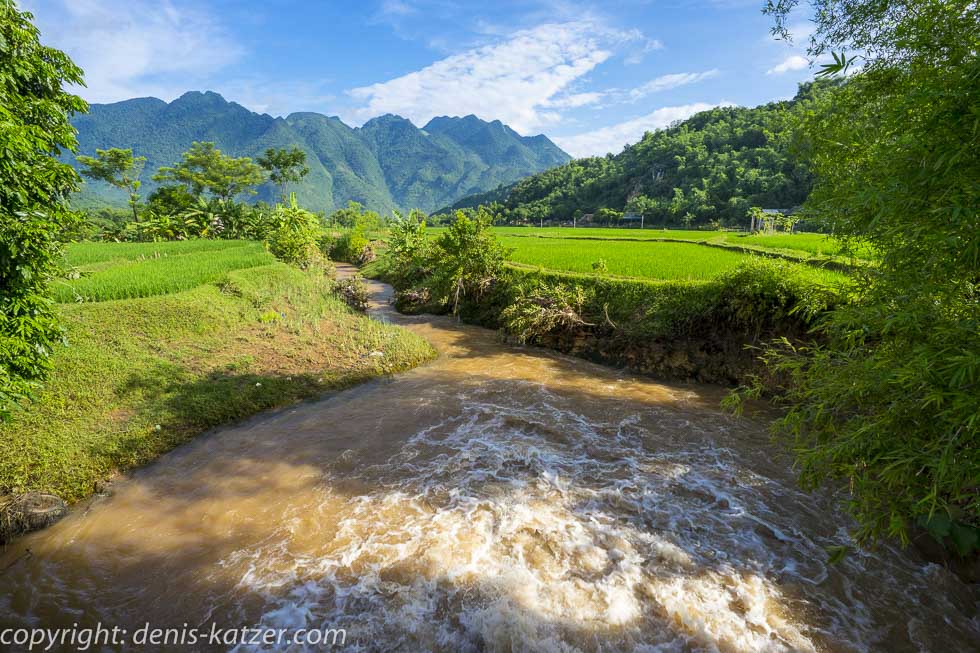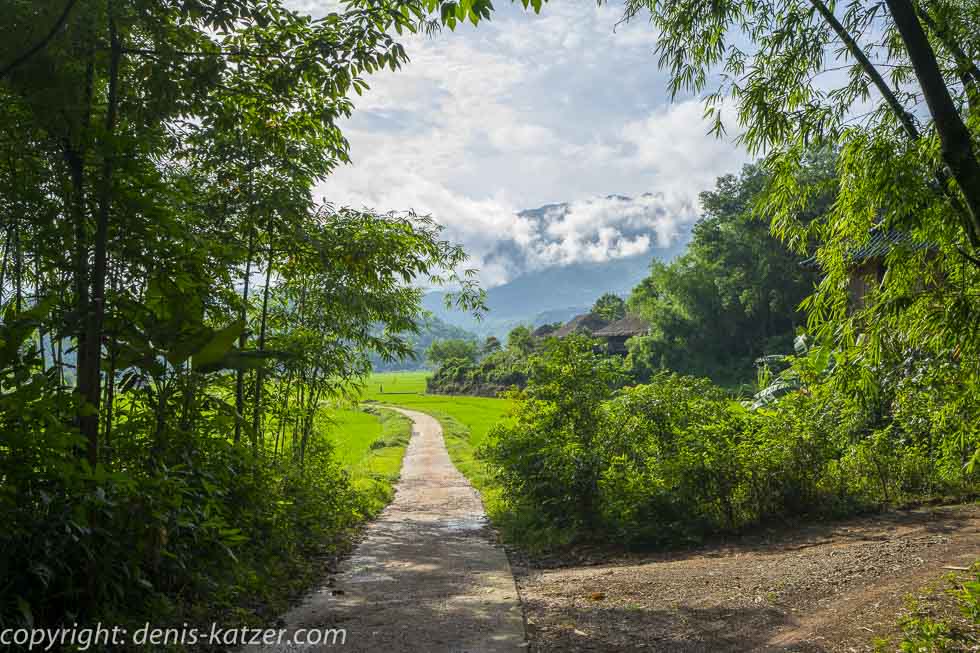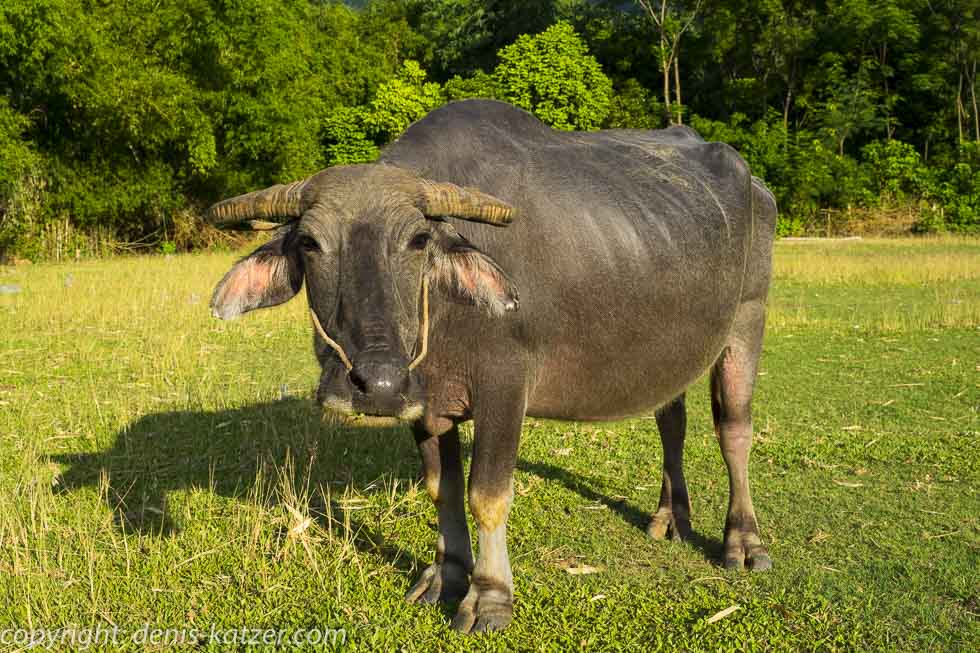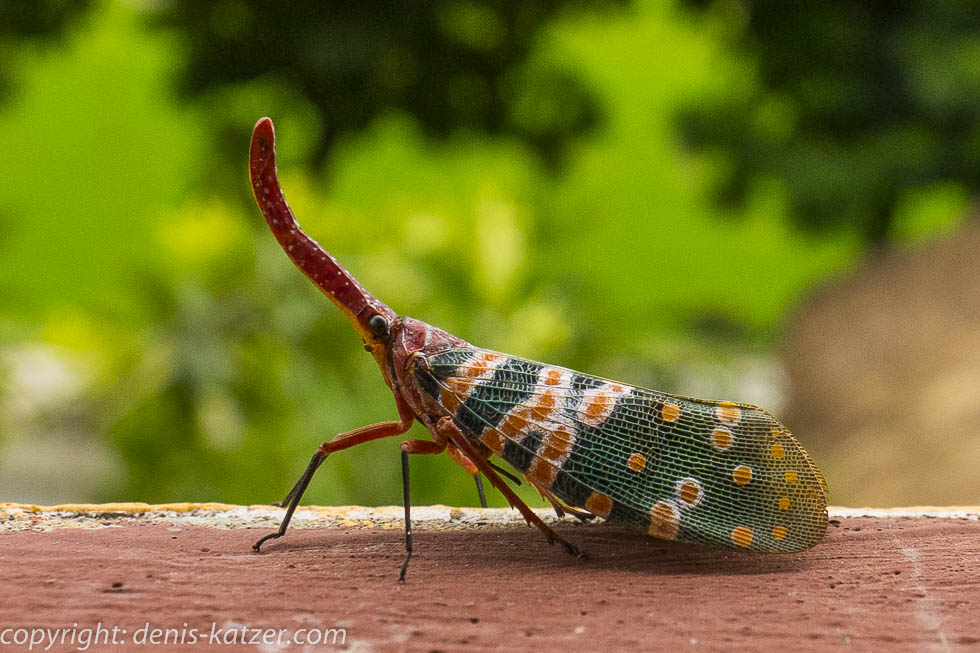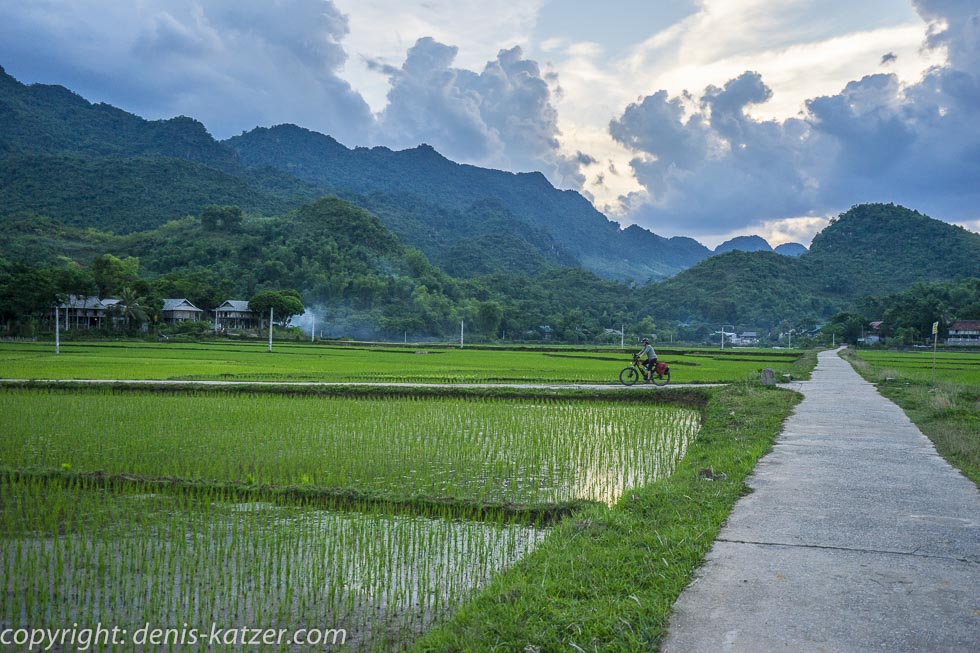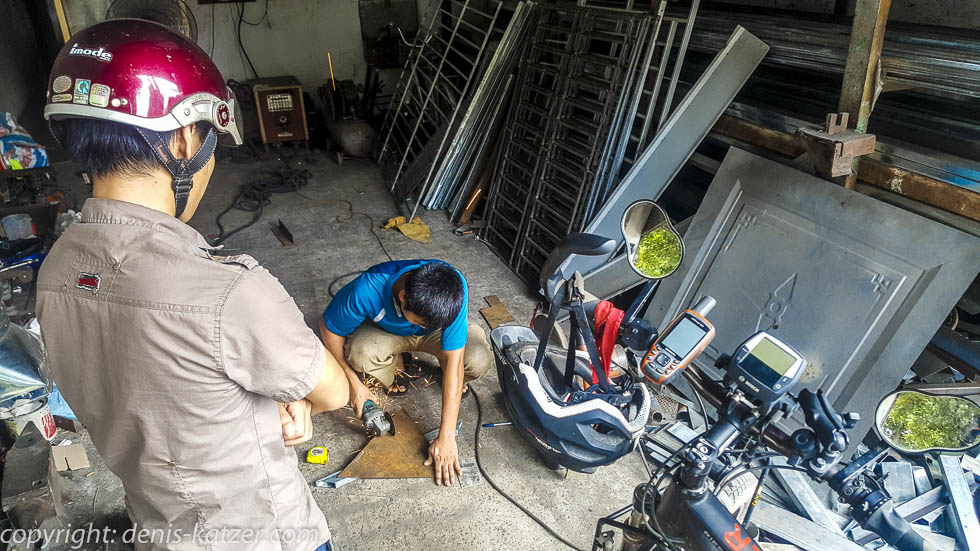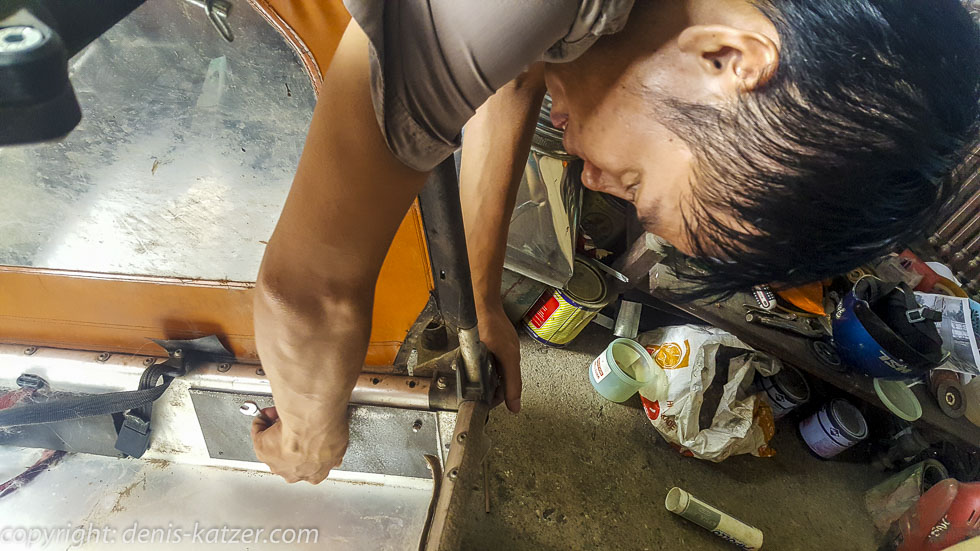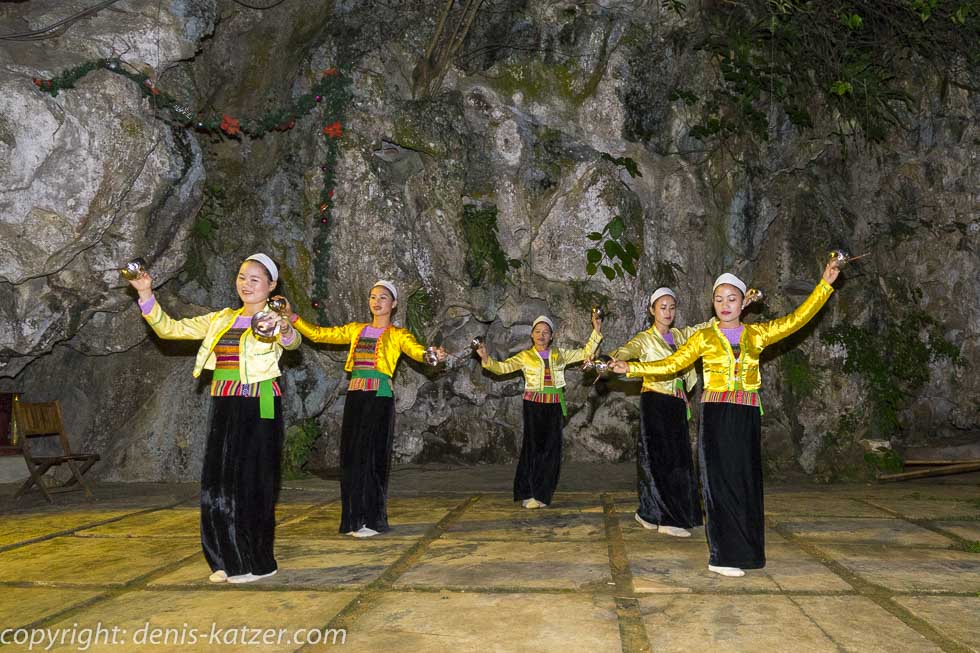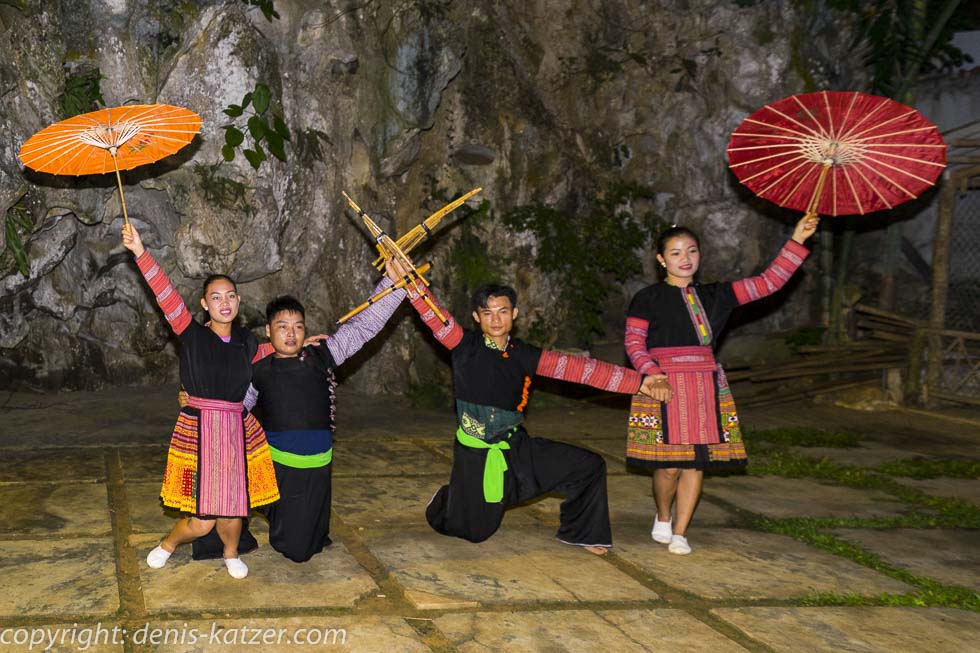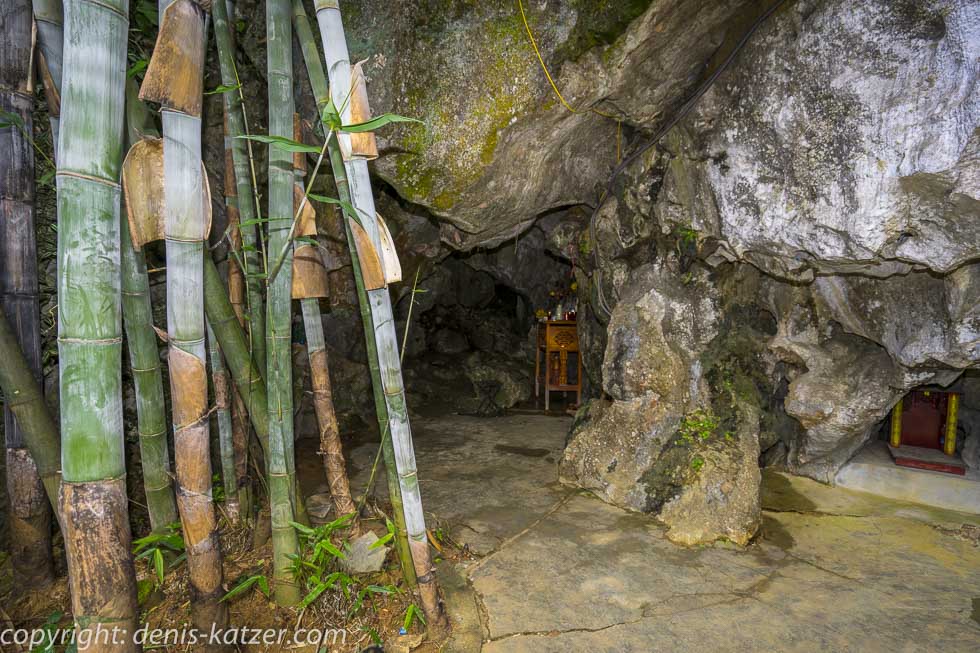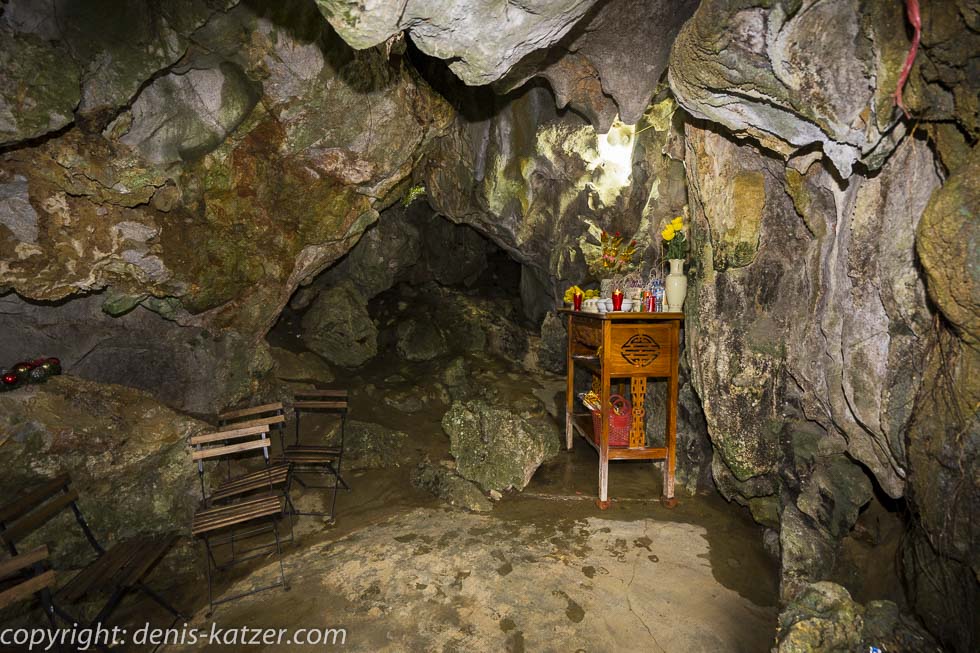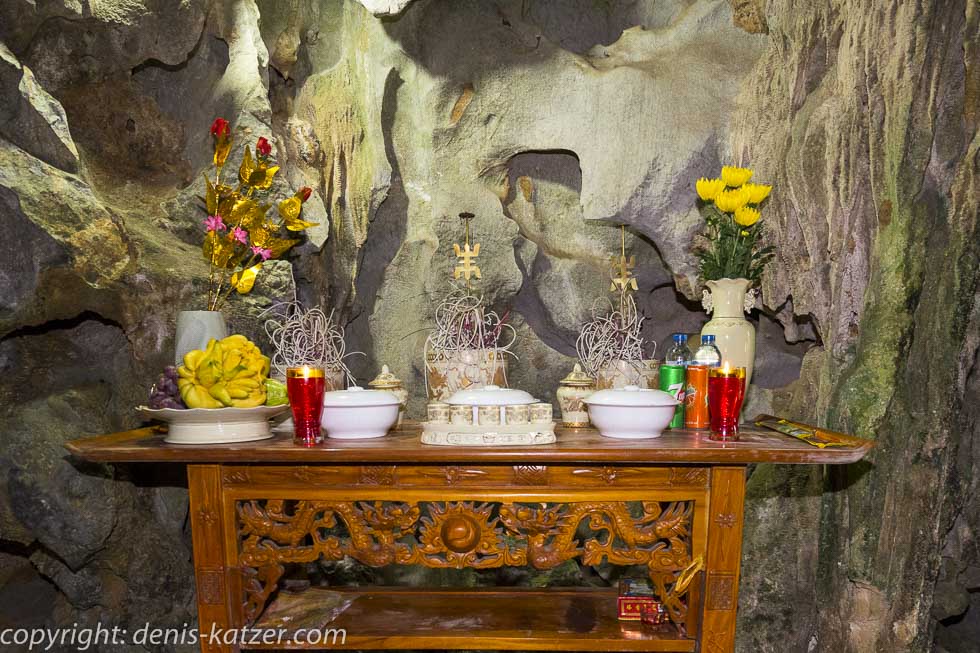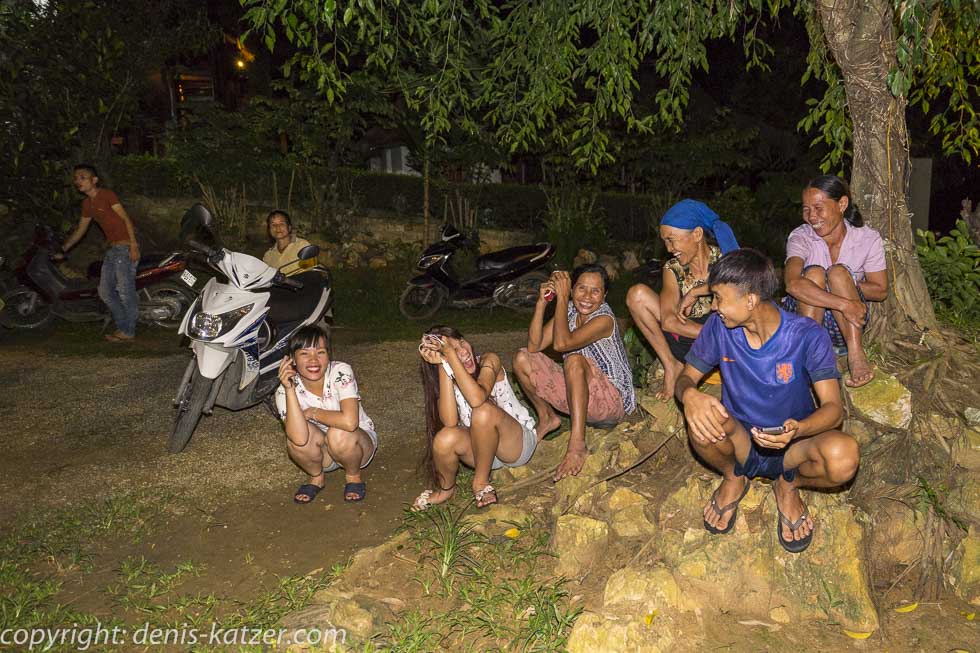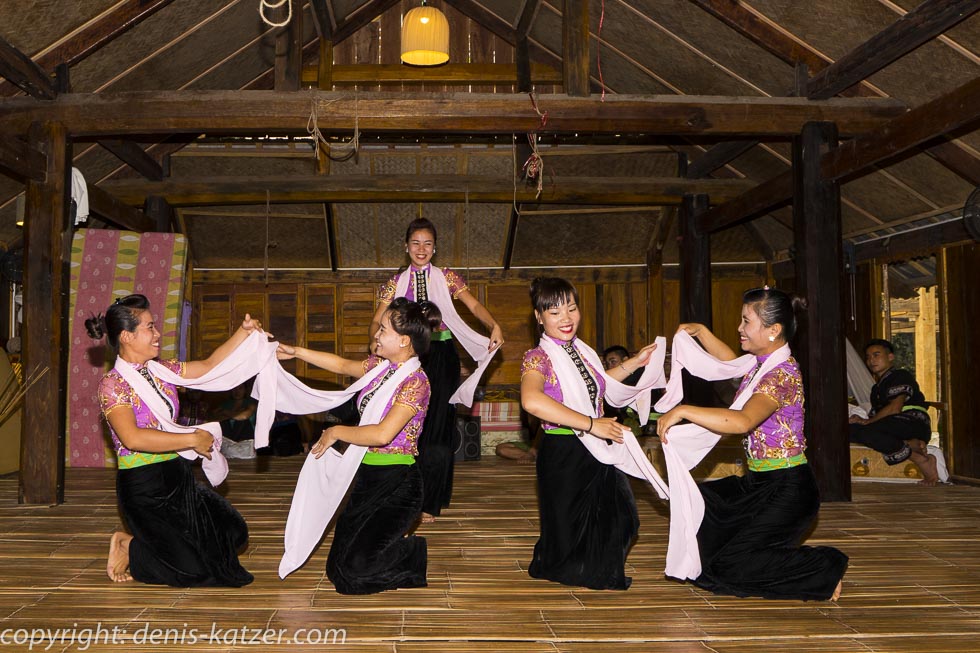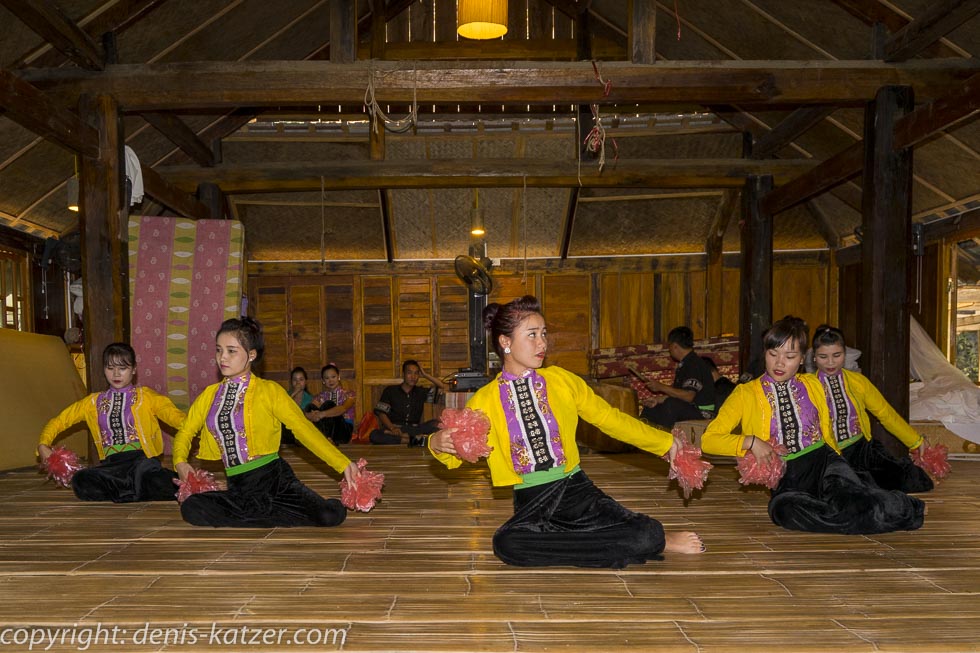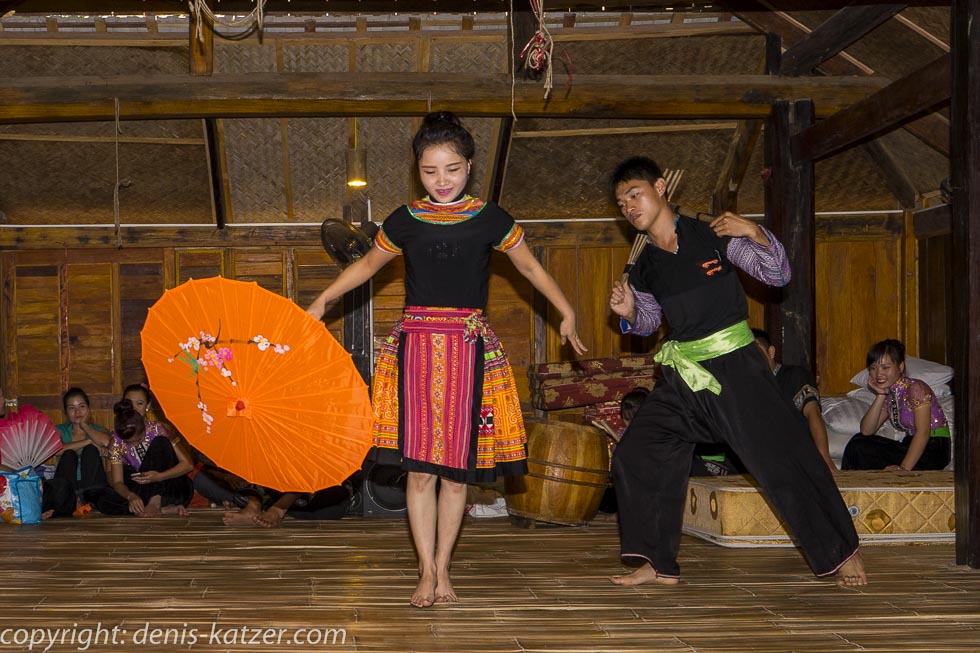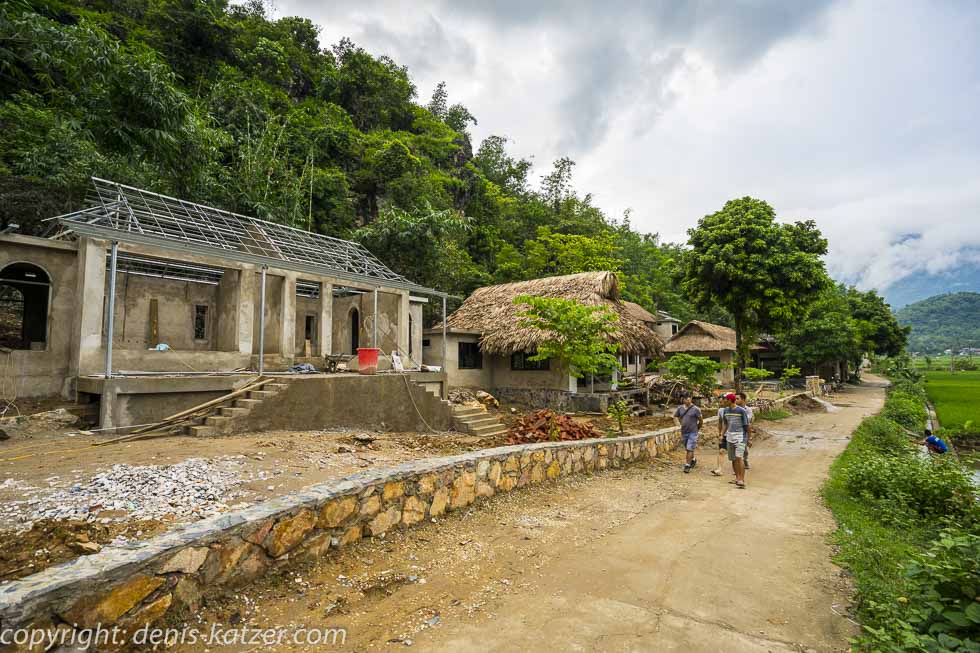
Life in the rice field
N 20°39'14.6'' E 105°04'01.5''
Date:
01.08.2016 until 05.08.2016
Day: 401 -405
Country:
Vietnam
Province:
Hòa Bình
Location:
May Chau
Latitude N:
20°39’14.6”
Longitude E:
105°04’01.5”
Total kilometers:
18,156 km
Maximum height:
190 m
Total altitude meters:
54.835 m
Sunrise:
05:33 h – 05:35 h
Sunset:
6:38 pm – 6:36 pm
Temperature day max:
32°C
Temperature day min:
21°C
(Photos of the diary entry can be found at the end of the text).
We enjoy our stay at the Nature Lodge, nestled in the rice fields, where you simply can’t get enough of the view. The staff are extremely friendly and courteous. Somehow we are lucky to be staying here these days, because the owner Man Do has sold 70 percent of the guest house he built in his own sweat to four investors. This means that it will be at least three times as big in a few months. Next door, up to 30 workers are building another 7 bungalows, which may mean that the idyllic family atmosphere will inevitably suffer. But no matter, it’s absolutely pleasant here now and we are reveling in the moment of being.
Our days are filled with recording our experiences, archiving the many pictures and answering readers’ questions. While I’m busy hitting the keys, Tanja drives to the capital Hanoi, 140 kilometers away, to pick up our second passports with the additional Vietnam and Laos visas. The company that arranges the visas for us in Germany sent the passports to the German Embassy, where they were kindly kept for us. Once Tanja is back and we have checked the visa details again to make sure they are correct, we start planning the route to Laos. “Can we make it to the Laotian border in 12 days?” asks Tanja. “It’s just under 500 kilometers to get there. That shouldn’t be a problem. Tomorrow I’m going to Mai Chau with Ka (manager of the Nature Lodge) to repair the trailer. After that, we’ll be ready for a longer journey again,” I say confidently. That same day, I work out a route through Laos. Our destination may be the Elephant Conservation Center in northwest Laos. There we want to find out whether it is possible to cross part of Laos with an elephant as an alternative to our planned elephant trip in Myanmar. This will be part of our next e-bike tour, during which we want to explore Myanmar, Thailand, possibly Laos, definitely Malaysia and Indonesia from Sumatra to the island of Timor. Because elephants are my favorite animals, I have dreamed of traveling with a pachyderm since my early childhood. Back in 1996, we had already crossed the lowlands of Nepal along the Indian border with our elephant cow Bawan Kumari, which translates as the maiden of the air. However, Bawan was caught in the wilderness and was forced to work by the humans. We bought her time off work for the duration of our trip. Unfortunately, we were not told that Bawan was understandably not on good terms with humans, which is why she killed three of her mahouts (elephant handlers). She also tried to kill us or other passers-by several times during our trip at the time. Fortunately, I only injured my right shoulder during an attack. The next time we travel with an elephant, we’ll try to get one with a peaceful disposition. The purpose of this extraordinary elephant excursion is not just the joy of being out and about with such a large animal, but above all to draw attention to the global threat to elephants, the illegal ivory trade and the mass killing of 30,000 elephants a year. Before we Europeans came to the African continent, it is estimated that up to 20 million elephants lived there. In 1979, the figure was still around 1.3 million. From 2007 to 2014, a third of the entire African elephant population was shot, mostly by poachers. They are already extinct in parts of the Democratic Republic of Congo, Cameroon and Zambia. The threat to Asian elephants is in no way inferior. There are numerous reasons for this. Tanja and I are convinced that through a personal bond between us and an elephant and our journey together, we will learn a lot about this animal and reach many people through our story. An extremely exciting undertaking that we are already looking forward to. As it is certainly not easy to get an elephant, it is not wrong to put out feelers now.
In the evening, we sit in the small garden and chat with tourists, most of whom come directly from Hanoi just for a day in the valley of lush rice fields to explore the beauty of the area on a short bike ride or hike. “Well, you look really annoyed,” I say to a young Englishman who is sitting in a chair and looking down at the floor. “I’m pissed off. That’s true. My friend Ben’s moped broke down eight times on the way from Hanoi to here. It was a bad ride and now we’re stuck here because the garage is closed.” “Sorry, it might sound a bit stupid, but everything that happens has a purpose. Maybe you should stay in this beautiful place for a few days and enjoy life,” I explain, at which point his face lights up and we start talking. It doesn’t take long before his friend Ben is sitting at the table. Our wavelength is right from the very first moment and the initial question develops into a conversation that lasts until 2:00 in the morning. The two want to cross Vietnam from north to south within three weeks. A crazy route that is impossible to cover if you want to see something of the country. The next day they are still at the lodge because Ben’s moped is broken again after another repair. Now the mechanic wants to overhaul the thing. They can now laugh about the situation and try to make the best of their forced stay in paradise.
The next day, I travel with Ka to the small town of Mai Chau. The helpful manager has found a metalworking workshop. We show the craftsman the place where the floor pan is to be reinforced. He nods, gets on his moped and rattles off. Five minutes pass when he reappears with a triangular piece of sheet metal about 2 millimeters thick. He shows how he wants to flex a suitable strip out of the heavily rusted part. “Okay,” I say, whereupon he begins his work. “Look at this,” says Ka, pointing to the crack in the floor pan that can be seen after unscrewing the new drawbar shaft. “Wow, that wouldn’t have lasted much longer,” I reply, shocked and relieved to have avoided a serious breakdown just in time.
An hour later, Ka, the workshop owner and I reinforced the floor pan with the now polished metal strip we had made. “It certainly won’t tear at this point,” I laugh. “What do I owe you?” I ask the friendly man. “90,000 dong” (€3.60), he says. Thank you. As I had to pay 200,000 dong (€8) for four drilled holes in Sa Pa, I am particularly pleased with the honesty of the mechanic. On the way back to the lodge there is no more cracking, so I hope to have solved this problem once and for all.
The days pass quickly. In the late afternoons, we sometimes take short trips into the rice fields and watch the farmers at work. A girl sits on the riverbank in the shade of a tree and watches over her water buffaloes as they take a bath. Miserable huts stand on poor stilts in the middle of a sun-drenched rice field. A farmer’s wife washes her clothes in an irrigation canal. The romantic view of the scene cannot hide the poverty of some of the people living here. Most of them belong to the ethnic minorities of the Thai people. They still live in the traditional stilt houses, where all social life takes place in a single room. At night, this airy space becomes the family’s bedroom and during the day it is used for eating, resting, discussing and sometimes celebrating. On festive occasions, the Thai wear colorful hand-woven clothing that they produce themselves on the loom at great expense.
“Actually, I’d like to stay here longer,” I say to Tanja during a short hike, not yet knowing what fate has planned for us. “I really like it too, but you said yourself that we need at least 10 days to get to the Laotian border.” “Yes, yes, I know. The stupid residence restrictions in the countries are really annoying.” “There are also some nice places on the way.” “You’re right,” I reply, knowing that I won’t be able to stay forever and looking forward to what awaits us in Laos.
Dooong! Doong! Dong!, the drumbeats call us to the traditional evening dance of an ethnic group. We walk to the place where, in good weather, the guests eat their meals or meet up for a chat. A rough rock face overgrown with tropical plants borders the small grounds of the lodge. About 10 visitors sit on their chairs and watch the women and men dance. Colorful dresses, smiling faces, graceful dance movements, the strange music and the rhythm of the drumbeats transport us to another time. My eyes glide over the 50-metre-high rock face, which shimmers darkly in the diffuse light, and lose themselves in the blackness of a small cave. Incense and fruit are sacrificed to the gods on a wooden altar in the center. “Because the French air force had bombed our small hospital in Mai Chau during the Indochina War, the doctors had to go into this cave to operate on the seriously injured using the simplest of means. You can feel how cold it is in the cave. It doesn’t matter what the temperature is outside, it has always been comfortable for the patients inside. For us, this cave is a memorial to this terrible war. It is a sacred place for us, where we remember our deceased ancestors and make daily sacrifices,’ Ka explains to me.
In the evening, I have a few more beers with Louis and Ben. They set off this morning with their repaired bikes. Ben’s moped broke down again after a few kilometers, which is why they came back at lunchtime. Tomorrow they want to buy a new moped so that they can finally start their tour through Vietnam. “See you tomorrow then. I’ll keep my fingers crossed that it works out this time,” I say as I say goodbye to the nice guys…
If you would like to find out more about our adventures, you can find our books under this link.
The live coverage is supported by the companies Gesat GmbH: www.gesat.com and roda computer GmbH http://roda-computer.com/ The satellite telephone Explorer 300 from Gesat and the rugged notebook Pegasus RP9 from Roda are the pillars of the transmission. Pegasus RP9 from Roda are the pillars of the transmission.
